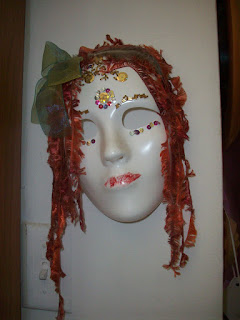 They're back...arriving each year without failure at the same time. They leap upon us like a tiger leaping on its pray. And you know that before you even digest your Thanksgiving meal you're thrust into the holiday madness. With this madness comes spending, giving, receiving, colds, expectations, sugar, stress, invites, aloneness, pressure and the list goes on. It's difficult to not get caught up in the change of energy the holidays bring. Every year, I try to take a step back and just observe, but at some point, usually the day before Christmas, the guild sets in and I dash to the closest shopping center to pick a few gifts up. Each year, I write in my journal that this year is going to be different. I will give from my heart; I will give of my time; I will give only if I wish to. I'm even feeling this way as I write in my blog. The question always becomes to give or not to give? But this piece is not about whether to give or not to give, it is about taking care of yourself artfully during the holidays. It is about if you feel the holiday blues beginning to sneak in, how can you care for yourself during the dark periods that can emerge like a winter chill. As I like to say, when in doubt, create! For me that means, draw, knit, write, bake, work in my garden, make my holiday cards, journal, rearrange my home, expose myself to creativity around the city and finally, to read. I read and I discover ideas. For each of us our creativity is a personal process. It is something that sparks your soul. Something that is a reflection of you. It does not have to be about perfection unless maybe you are painting your home, and even then a little mistake here and then will not be noticed.
They're back...arriving each year without failure at the same time. They leap upon us like a tiger leaping on its pray. And you know that before you even digest your Thanksgiving meal you're thrust into the holiday madness. With this madness comes spending, giving, receiving, colds, expectations, sugar, stress, invites, aloneness, pressure and the list goes on. It's difficult to not get caught up in the change of energy the holidays bring. Every year, I try to take a step back and just observe, but at some point, usually the day before Christmas, the guild sets in and I dash to the closest shopping center to pick a few gifts up. Each year, I write in my journal that this year is going to be different. I will give from my heart; I will give of my time; I will give only if I wish to. I'm even feeling this way as I write in my blog. The question always becomes to give or not to give? But this piece is not about whether to give or not to give, it is about taking care of yourself artfully during the holidays. It is about if you feel the holiday blues beginning to sneak in, how can you care for yourself during the dark periods that can emerge like a winter chill. As I like to say, when in doubt, create! For me that means, draw, knit, write, bake, work in my garden, make my holiday cards, journal, rearrange my home, expose myself to creativity around the city and finally, to read. I read and I discover ideas. For each of us our creativity is a personal process. It is something that sparks your soul. Something that is a reflection of you. It does not have to be about perfection unless maybe you are painting your home, and even then a little mistake here and then will not be noticed.Wednesday, December 9, 2009
Making your way through the holidays with creativity
 They're back...arriving each year without failure at the same time. They leap upon us like a tiger leaping on its pray. And you know that before you even digest your Thanksgiving meal you're thrust into the holiday madness. With this madness comes spending, giving, receiving, colds, expectations, sugar, stress, invites, aloneness, pressure and the list goes on. It's difficult to not get caught up in the change of energy the holidays bring. Every year, I try to take a step back and just observe, but at some point, usually the day before Christmas, the guild sets in and I dash to the closest shopping center to pick a few gifts up. Each year, I write in my journal that this year is going to be different. I will give from my heart; I will give of my time; I will give only if I wish to. I'm even feeling this way as I write in my blog. The question always becomes to give or not to give? But this piece is not about whether to give or not to give, it is about taking care of yourself artfully during the holidays. It is about if you feel the holiday blues beginning to sneak in, how can you care for yourself during the dark periods that can emerge like a winter chill. As I like to say, when in doubt, create! For me that means, draw, knit, write, bake, work in my garden, make my holiday cards, journal, rearrange my home, expose myself to creativity around the city and finally, to read. I read and I discover ideas. For each of us our creativity is a personal process. It is something that sparks your soul. Something that is a reflection of you. It does not have to be about perfection unless maybe you are painting your home, and even then a little mistake here and then will not be noticed.
They're back...arriving each year without failure at the same time. They leap upon us like a tiger leaping on its pray. And you know that before you even digest your Thanksgiving meal you're thrust into the holiday madness. With this madness comes spending, giving, receiving, colds, expectations, sugar, stress, invites, aloneness, pressure and the list goes on. It's difficult to not get caught up in the change of energy the holidays bring. Every year, I try to take a step back and just observe, but at some point, usually the day before Christmas, the guild sets in and I dash to the closest shopping center to pick a few gifts up. Each year, I write in my journal that this year is going to be different. I will give from my heart; I will give of my time; I will give only if I wish to. I'm even feeling this way as I write in my blog. The question always becomes to give or not to give? But this piece is not about whether to give or not to give, it is about taking care of yourself artfully during the holidays. It is about if you feel the holiday blues beginning to sneak in, how can you care for yourself during the dark periods that can emerge like a winter chill. As I like to say, when in doubt, create! For me that means, draw, knit, write, bake, work in my garden, make my holiday cards, journal, rearrange my home, expose myself to creativity around the city and finally, to read. I read and I discover ideas. For each of us our creativity is a personal process. It is something that sparks your soul. Something that is a reflection of you. It does not have to be about perfection unless maybe you are painting your home, and even then a little mistake here and then will not be noticed.Monday, December 7, 2009
Centering

Tuesday, October 27, 2009
Creating Mandalas in Sickness & Health

Tuesday, September 8, 2009
Mandala Painting Workshop

Monday, August 17, 2009
Internal Critics Move Aside
Learning to talk to your internal critic can be a daily practice that takes place in a journal or whenever you encounter the negative-thinking voice. Awareness that it is taking place is the first step. Acknowledging that it exists must happen before you can confront it. I tell clients to draw or write in a journal to practice working with the judgemental voice inside of them. When issues of perfection, or feelings of making a mistake arise, I ask clients to acknowledge the feeling, and try to stay with the process allowing their art to be what it wants to be. So, as you work in a journal, be aware of what is happening as you draw or write. Be aware of your reactions, and instead of doing what you've done in the past, try something new. Try gently asking the critic to please step outside, because, you know what you are doing and do not need his or her help. Continue to work with this process until you feel you can work freely and comfortably allowing the process to take place without judgement.
Sunday, July 19, 2009
Giving Children a Voice Through Art-Making

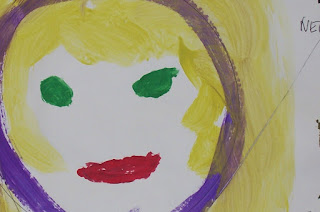
Tuesday, July 14, 2009
THE FEAR OF A R T
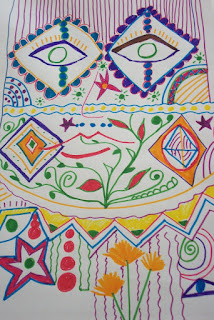 Staring at a blank page can be intimidating to say the least. Where to begin? What color to choose? What if I make a mistake? What will others think? What if it's not good enough? These concerns are all the voice of our internal critic playing havoc on our psyche. These messages might be the result of some childhood experience with art or any other experience, where we were told something to the effect of, that's not how you draw a (fill in the blank.) The internal critic is the creature who resides inside of us telling us that we are not good enough or perfect enough.
Staring at a blank page can be intimidating to say the least. Where to begin? What color to choose? What if I make a mistake? What will others think? What if it's not good enough? These concerns are all the voice of our internal critic playing havoc on our psyche. These messages might be the result of some childhood experience with art or any other experience, where we were told something to the effect of, that's not how you draw a (fill in the blank.) The internal critic is the creature who resides inside of us telling us that we are not good enough or perfect enough.I remember a creative writing course I took years ago, where we were asked to write about why we were taking the course. I begin my piece by saying that I was taking the course because....As students began to read what they had written, I became numb and wanted to leave the room asap. When the instructor asked what I had written a chill encased my body and I said something to the effect of, "it is not very good and..." The instructor responded, we are all at different places with our writing and you must respect where you are in this creative journey. Hey, I like that I thought. Respect where I am in the process. That makes sense. Whether you are writing, painting, engaging in another creative or self-expressive process, respect where you are in the process. Beginnings can be challenging, but what are the consequences of not beginning? Where would we be if we did not crawl, sit up or walk? The same is true for the creative process. When I began writing poetry, I was told to begin with,"this is a poem about..." I could always go back later and change the first line. The same is true for art, though we can't always change the images, we can add to them, we can add color or shapes to them and we can allow ourselves to be present with the process instead of thinking about the product.
Tip 1: begin with collage - it is less intimidating than drawing. Though you can begin drawing experimenting with color, shape and images.
Tip 2: Focus on process
Tip 3: Remember to have fun
Tip 4: Tap into your beginnner's mind
Tip 5: Leave perfection at the door
Tip 6: Invite imperfection in
Tip 7: Let your heart speak
Next time you come across a blank page, ask it what it wants from you, where it would like you to begin and allow your heart to speak.
Friday, July 3, 2009
AnXieTy: Can Creating Art Really Help Me?

I would introduce how creating mandalas, (Sacred Circle) can help promote calm during bouts of anxiety and worry. Drawing a circle can be done in almost any setting. I don't recommend it while you are driving. But, if you keep a pad with you, you can create a circle while waiting for a doctor's appointment, studying, before a test, waiting for a blind date to arrive or pretty much any situation that brings anxiety and/or worry on. I have made a few suggestions about approaching your circle below.
Promoting Calm Amidst Anxiety & Worry
- Keep a journal or pad with you at all times.
- BREATE
- Keep a few colored pencils, markers or regular pencils with you
- You might have the blank pages already traced with with a circle
- The circle can be any size you wish
- Begin in the center of the circle and draw outward
- Leave perfection and judgements outside
- Staying within the circle, allow your pencil to led the way
- It might be helpful to choose calming colors
- Focus on the circle
- Breathe
- Continue drawing until you feel you have reached a place of calm
- Finish when you feel your mandala is complete
- Bring this calm with you and return to the circle when you feel anxiety surfacing again
- Move on to what tasks need your attention
Saturday, June 20, 2009
Creating Mandalas for Healing...
The word Mandala, comes from the Sanskrit language meaning “sacred circle.” The use of mandalas throughout time have been used by various cultures for meditation, self-reflection, healing and as a symbol for the self.
In this weekly group, we will create mandalas from various art mediums including oil and chalk pastels, markers, colored pencils and collage. The workshop is meant to provide a relaxing and reflective experience that supports and promotes healing.
No art experience necessary.
Group begins, Thursday, July 7th, 2009
6pm-8pm
WEST LOS ANGELES LOCATION
$20 Per session
SUPPLIES PROVIDED
Facilitated by Victoria Van Zandt, MA
Registered Art & Marriage & Family Therapist
Intern #52087
No art experience required.
Please call for more information and/or to participate in the group.
Call 310-922-3957
Supervised by Gwen Lotery, MFT #37140
Monday, June 15, 2009
Mandalas For Reflection, Meditation & Healing

Thursday, June 4, 2009
Doodling Our Stress Away
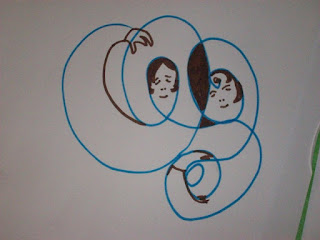 The Oxford Pocket Dictionary defines doodling as scribble or draw, esp. absentmindedly. I especially like the use of the word, absentmindedly, because if we are doing something absentmindedly or without the mind, there is a tendency to be more at ease. So, it would make sense that if the mind or for that matter, the thinking brain, is at rest and not obsessing, one could experience calm. I have not done research on the relationship between doodling and relaxation, but I tend to believe that while we doodle, our brains are resting, compared to when we are sitting around waiting nervously for a physical exam or academic test to begin.
The Oxford Pocket Dictionary defines doodling as scribble or draw, esp. absentmindedly. I especially like the use of the word, absentmindedly, because if we are doing something absentmindedly or without the mind, there is a tendency to be more at ease. So, it would make sense that if the mind or for that matter, the thinking brain, is at rest and not obsessing, one could experience calm. I have not done research on the relationship between doodling and relaxation, but I tend to believe that while we doodle, our brains are resting, compared to when we are sitting around waiting nervously for a physical exam or academic test to begin.There are a few ways to approach doodling. For instance, you can put pen, pencil or marker to paper and let them lead the way as if they have command of the page and see what happens. You can continue that process and after you have completed your doodle, look for an images that surface and color them in. That is what I did with the piece attached to this blog above. You can use color or black and white. I happen to enjoy doing this type of doodling. You can doodle with an image already in mind, but then I'm not sure it is really doodling, but none-the-less, your mind is elsewhere then on pressing issues. Doodling can be done on paper napkins, the little cardboard coffee holders, newspaper, Styrofoam cups and/or anywhere that is free for the taking. I love the fact that you really can get lost in the process of doodling and free one's mind for a few moments. I have made doodles that I've turned into larger pieces by taking the original doodle and having it enlarged at a printing store. It is endless what you can do with doodling. Next time you are feeling anxious instead of reaching for the Valium, try reaching for a pad and pencil. It might just do the trick!
Peace in Art-Making
Tuesday, June 2, 2009
Art Speaks Louder Than Words
Thursday, May 28, 2009
Why Art Therapy?
Feel free to contact me for more information on art therapy and how and where it is used and its benefits.
Peace
Thursday, May 21, 2009
In Sickness & In Health - allow Art to Lead The Way
 My hand drawing from first grade...who knew?
My hand drawing from first grade...who knew?Peace
Monday, May 18, 2009
COLLAGING
I'm a big supporter of the art-making process of collage. The Oxford Pocket Dictionary defines "collage" as work of art in which various materials are arranged and glued to a backing. I would like to add, that found objects such as shells, , fabrics, photographs, tree bark, string, yarn and different textured papers can be included in a collage. You can mix mediums and use them to draw or paint onto the collage, for instance including paint, colored pencils and markers. I use collage with clients because it takes the pressure of having to draw or paint away from the art-making process. What else I enjoy about working with collage is that whatever issue a person is working on or trying to understand in their life, collage offers a nonintimidating method to explore thoughts and feelings. Magazine cut-outs provide a variety of images that can be used to represent thoughts and feelings. For instance, lets say an individual wanted a deeper understanding of his or her relationship with their sister. I might suggest that they choose images that reflect what he or she likes about their sister and images that represent what they do not like. I usually recommend that they choose between 8 and 10 images so that they are not using the entire session to go through the many picture cut-outs. Once the pictures are glued down, I will ask clients to talk about the process and share any thoughts or feelings they have about the images they chose. Together we explore the art.
Try it for yourself:
Exercise: Introduce yourself with images. Instead of introducing yourself with words, you will do it with images.
Begin collecting magazine picture cut-outs such as people, animals, places, buildings, plants, sayings, words, things, etc. Keep them in a box.
You'll need: glue, scissors, large plain paper or cardboard.
This can be a work in process. Start by choosing images that you feel define who you are, where you are in your life and other aspects of yourself you would like to share.
Glue images to the paper/board in away you wish. Overlapping if you choose.
Continue until you feel your collage is complete. Reflect on the process and if you wish, you may write a short story or poem about the collage/process.
Title your collage.
Wednesday, May 13, 2009
Being Fired...Can Be A Blessing in Disguise
Tuesday, May 12, 2009
Using Collage to Tell the Story of Your Life
"Enough is Enough" a time for change
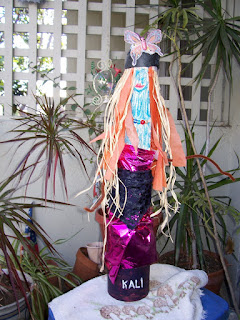 To the left, my art-piece Kali-Ma. This goddess represents my inner demons that I work hard to understand and abolish such as negative self talk and doubt. She is also with me in my fight to be heard from my healthcare team and insurance companies.
To the left, my art-piece Kali-Ma. This goddess represents my inner demons that I work hard to understand and abolish such as negative self talk and doubt. She is also with me in my fight to be heard from my healthcare team and insurance companies. I've been reading Jean Shinoda Bolen's book, "Goddesses in Older Women...archetypes in women over fifty," and can not put it down. I've found wonderful ideas for art directives as I turn the pages of this fascinating book. In the chapter titled Goddesses of Transformative Wrath: Her Name is Outrage, Bolen speaks of the goddesses who come forth when it is time for us to take ction in order to make changes in our lives, or as she writes, when enough is enough. The two goddesses Bolen includes in this chapter include Sekhmet, the ancient Egyptian Lionheaded goddess and Kali-Ma, Hindu destroyer goddess. These goddesses come into our lives when it is time for change, when we have stayed in a relationship too long, or a job, or to speak out about a cause close to your heart. I am writing about this subject in Creative Journey instead of Wisewomen because of how we can use an idea such as enough is enough to go deeper into this idea with creative self-expression. I would like to suggest that with the theme of enough is enough, you create a collage, write a poem, drawing, painting or short story addressing this subject in your life today. Begin by writing the words enough is enough on a piece of paper, focus on the words, close your eyes and repeat the words. Be aware of what images come to mind as you say these words. When an image comes to you, begin to put the image down on paper. It might come in the way of words or images. Continue to work with this piece as you allow the paper to hold what it is you have had enough of in your life. When finished, reflect on the piece and let it speak to you. You may wish to add to it at a later time. If you are in therapy, bring it with you to share with your therapist. Many times when we engage in art-making feelings can surface so seek support from a professional if you need to. And remember, to be with the process.
Victoria
Wednesday, April 29, 2009
Mother's Day
Tuesday, April 28, 2009
Mend the heart--calm the mind workshop
"Mending the Heart--Calming the Mind: An Introduction to Expressive Art"
Wednesday April 29th, 2009
7-9pm
$30
Expressive art is an amazing tool to help anxious and fearful minds relax as the art becomes the container for the feelings, not the person's body and/or mind, and it is a guide to develop greater insight into one's life. The process of doodling is an example of how drawing helps the anxious mind relax. The power of expressive art stems from the ability of imagery to be the bridge to talking about feelings and accessing emotions easier and quicker than traditional talk therapy. In this introductory workshop, you will be invited to take part in a hands-on art experiential. Art materials provided.
Saturday, April 25, 2009
Power of the Dinner Table Ritual
TIP:
Be creative with your communication style with your child/children. Sit down and do a nonverbal drawing together about how you and your child's day was. All you need is a big piece of paper or small and markers. Each picks a color marker and take turns drawing images that represent your day.
When your down, talk about the images. You can learn a lot from pictures.
Hip to Social Media
Adam Lambert must win Idol
Susan Boyle must win England Has Talent or whatever it's called. And, she must not pluck her eyebrows!
Bo is reeking havoc in the White House - I told you they should have gotten a rescue!
Green saves money
Finally, government...stay out of my womb, out of my bedroom and wedding plans.
Friday, April 24, 2009
Bullying
Be Aware
Victoria
Marriage and Family Therapy Intern #52087
Supervisor Gwen Lotery, MFT #37140
art & guidance 4 the body, mind & soul
Thursday, April 16, 2009
Where my Art is
